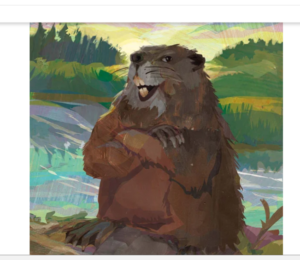This morning’s landscape bears a bright Ben Goldfarb review of Leila Philip’s new beaver book. It’s definitely worth visiting.
A Busy Hist ory
ory
How beavers shaped America—and not just its ecology
Beavers, you may have noticed, are having a moment. These tireless engineers build woody dams that form ponds, which in turn filter out water pollution, sequester carbon, furnish wildlife habitat and avert drought. The Los Angeles Times recently called the beaver a “superhero,” and the New York Times has deemed them “furry weapons of climate resilience.” Wetlands with beavers are so good at fighting megafires that some researchers have urged the U.S. Forest Service to switch mammal mascots from Smokey Bear to Smokey Beaver.
“[T]here is an element of the sacred in the beaver, if only in its deep weirdness …” writes Leila Philip in her engaging new book, Beaverland. “Is it any surprise that beavers have fired the human imagination in every continent that they are found?”
Well I believe Ben will be hired for the introduction of every beaver volume for the foreseeable future. And I’m okay with that, aren’t you? Leila’s take on Beaverland hits the shelves in a few short weeks and her personal journey with beavers started like this very website and some beavers that moved in close to home and captured her fascination.
Although Beaverland may never fully return to its former grandeur, the rodents have made a remarkable recovery. Philip’s odyssey takes her to many sites integral to their comeback, such as the farmhouse in upstate New York where conservationist Dorothy Richards once kept colonies of semidomestic beavers. (They sometimes chewed the legs off mahogany dressers.) She also visits a forest in New Hampshire where contemporary scientists are studying the hydrology of rebuilt beaver meadows: “giant underground sponges that can soak up and hold large stores of water,” thus saving watersheds from drought.
Beaverland visits many of our good friends – Owen and Sharon Brown of Beavers Wetlands and Wildlife, Mike Callahan of the Beaver Institute and Scott McGill of Ecotone, Sarah Koenigsberg, Ellen Wohl and even the dusty shores of Martinez.
Philip spends a lot of time with contemporary fur trappers. Pelts rarely fetch more than $20 these days, but some trappers still make a half-decent living killing beavers at the behest of agencies and landowners, who fret that expanding ponds will damage roads and private property. Philip admirably negotiates these complex interactions: she’s respectful of trappers’ hard-won knowledge of beaver behavior yet rightly skeptical about whether lethal control is the best way to solve conflicts (although she could have more forcefully refuted the self-serving claim that we need trappers to prevent beaver populations from running amok). Rather than resorting to traps, it’s better to use “pond levelers”—pipe systems that partially drain impoundments, thereby balancing human needs with rodents’ instinct.
Ben is in fact much kinder than I’m ever inclined to be. So I will only say that I have zero idea who the trapping chapters are being written for because I’m pretty sure it wasn’t me. And I doubt Bud from the Sportsman club is picking up this book any time soon. I can only assume it is an East coast thing. Where the wild world is so far away and long ago and the rocky shores are so peopled with undergrads that there is a warm golden nostalgia for the trappers who live by their own wits off the land the way we used to do.
Me? Not so much.
Near Beaverland’s end, Philip travels to Maryland, where a stream restorationist named Scott McGill collaborates with beavers to capture pollutants that would otherwise flow into Chesapeake Bay. “To build a stormwater management pond with that kind of water retention would cost one to two million dollars,” McGill says, nodding to a beaver compound. The rodents, of course, built it for free.—Ben Goldfarb
 Beaverland: How One Weird Rodent Made America
Beaverland: How One Weird Rodent Made America
by Leila Philip
Twelve, 2022 ($30)






































